Overview
-
Pros
- Excellent port selection
- Decent performance
- Wacom pen support
-
Cons
- Ugly design, flawed build
- Glossy display prone to glare
- Too expensive at launch
Bay Trail tablets are defined not only by
Windows 8.1 and the fourth-generation Intel Atom processor that powers
them, but also limited port selection, decent performance, and a low
price.
The Lenovo ThinkPad 10 is a Bay Trail tablet in that it features a fourth-generation Atom and runs Windows 8.1, but bucks this trend with a full array of inputs and outputs, and a price north of budget territory.
This might not be a bad thing, as the market is flooded with the
former from the likes of Dell, Toshiba, Asus, Acer, and HP. Also, the
vaunted ThinkPad brand has adorned excellent products in recent years,
leaving the experts at TabletPCReview hopeful that Lenovo has something good in store for business users. Let’s find out.
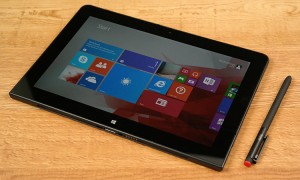 Those
familiar with ThinkPad products will instantly recognize the ThinkPad
10. It’s black with a handful of red and grey accents, as well a
semi-ruggedized and rubberized build tough enough to take a punch or
two. Like some other tablet devices in the ThinkPad line, it has rounded
top corners on the landscape side, contrasted with sharp bottom
corners, creating a flat bottom edge. While this has little to no
functional value, it does provide the ThinkPad 10 with a distinct look.
Whether it’s good or bad depends on personal preference, but more than
one of us at TPCR thought the tablet alone looks like it was ripped off a laptop or missing a bottom half.
Those
familiar with ThinkPad products will instantly recognize the ThinkPad
10. It’s black with a handful of red and grey accents, as well a
semi-ruggedized and rubberized build tough enough to take a punch or
two. Like some other tablet devices in the ThinkPad line, it has rounded
top corners on the landscape side, contrasted with sharp bottom
corners, creating a flat bottom edge. While this has little to no
functional value, it does provide the ThinkPad 10 with a distinct look.
Whether it’s good or bad depends on personal preference, but more than
one of us at TPCR thought the tablet alone looks like it was ripped off a laptop or missing a bottom half.
Unlike its slicker Windows tablet counterparts, there are relatively
large gaps where pieces connect, as well as around the buttons and
ports, often revealing circuit board edges. The Lenovo ThinkPad 10
simply looks unfinished, almost like a demo unit.
All this adds up to an ugly tablet.
It may look tough, but the build can’t hold up to fingertips. Smudges are a constant nuisance, and thanks to the texture, tough to wipe off. There is also no pen dock, despite the fact that the ThinkPad 10 supports and ships with a Wacom stick. This is likely to keep the device as thin and light as possible. To that end the ThinkPad 10 meets the standards set by the other Bay Trail models, measuring 10.1 x 7 x .35 inches (WDH) and weighing 1.3 pounds.

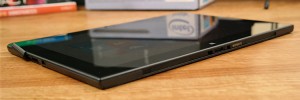
It feels sufficiently solid in hand, and well balanced. There is no creak when moderately strained, though the back panel has a little give when pressed. In addition to the aforementioned punch, the ThinkPad Tablet 10 could also likely survive a few drops, too.

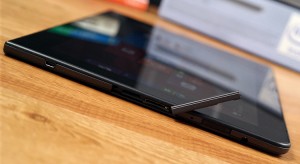
Display
True to its name, the ThinkPad Tablet 10 has a 10.1-inch IPS display with a 1920 x 1200 resolution, resulting in a 224 pixel-per-inch count and 16:10 aspect ratio. That PPI count is actually higher than the Surface Pro 3’s 216 ppi, owing mostly to the Pro 3’s larger 12-inch display. Microsoft’s flagship tablet has one up on the ThinkPad 10 with a boxier 3:2 aspect ratio though, which proves itself superior for Windows 8 than the more common 16:9 and 16:10 ratios because of the increased vertical workspace. Heavy Excel users especially understand the value of a taller display.
The display quality is acceptable, with sufficient viewing angles. The whites are a bit off, with a slight warm tone, but contrast is pleasant. Glare is a persistent issue thanks to the glassy and glossy display, and even max brightness isn’t enough to cut through in most instances.
Like the Pro tablets, the ThinkPad 10 supports up to ten touch inputs, and like the original Pro and Pro 2 (and Asus VivoTab Note 8), it also supports Wacom active pen input (the Microsoft Surface Pro 3 relies on rival N-trig).
Pen
 The ThinkPad 10 ships with a Wacom pen, which will be familiar to Galaxy Note
and previous-generation Surface Pro owners. It’s comparable to a
standard Bic pen in length and weight, complete with clip, one button on
the pen, and another on the eraser end. Pressure sensitivity registers
at 1,024 points. Its slight texture makes it pleasant to grip, though
some at TPCR can’t help but think N-trig pens have superior weight and balance owing to their internal batteries.
The ThinkPad 10 ships with a Wacom pen, which will be familiar to Galaxy Note
and previous-generation Surface Pro owners. It’s comparable to a
standard Bic pen in length and weight, complete with clip, one button on
the pen, and another on the eraser end. Pressure sensitivity registers
at 1,024 points. Its slight texture makes it pleasant to grip, though
some at TPCR can’t help but think N-trig pens have superior weight and balance owing to their internal batteries.
The pen does hover actions a few centimeters away from the display, but not as far as the N-trig Pro 3 pen and not nearly as far as the Pro 2 Wacom stick. In terms of accuracy, the pen has no trouble registering fast pen strokes, though will veer off a ruler’s edge at moderate speeds as well as when applied at moderate angles. It also slightly skews as the display’s landscape edges.
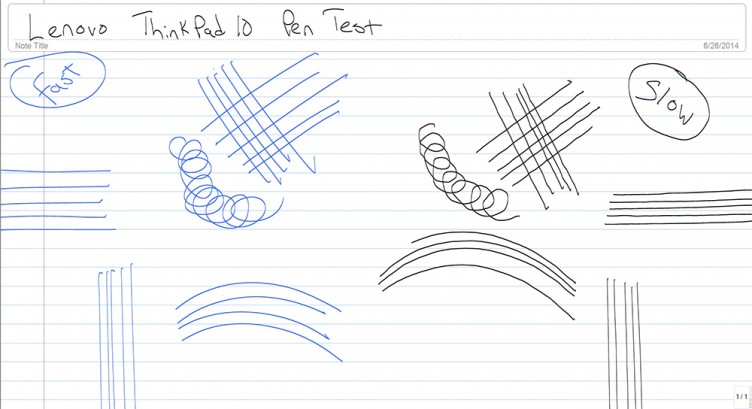
Ports, Inputs, and Buttons
The bottom edge appears jarring at a glance, as it leaves various docking and secondary charging elements exposed. A quick look at the other edges reveals a power button and display lock on the top. A Lenovo proprietary charging input resides on the left landscape side, next to a covered USB 2.0 input. The left landscape side houses a microHDMI output, covered microSD and micro-SIM slots, emergency reset pinhole, volume rocker, and a 3.5mm audio jack.
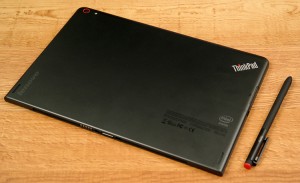 The
display dominates the front, along with a 2/3-inch bezel. The
2-megapixel front facing camera, light sensor, and onboard microphone
sit right to left on the front, while a small Windows softkey rests on
the bottom center.
The
display dominates the front, along with a 2/3-inch bezel. The
2-megapixel front facing camera, light sensor, and onboard microphone
sit right to left on the front, while a small Windows softkey rests on
the bottom center.
There is a lot going on the back of the tablet, with an 8-megapixel shooter on the top-left corner next to another light sensor and flash, and the familiar ThinkPad branding, complete with red indicator light, on the right. Some models have a fingerprint sensor (the TPCR review unit does not), while all have speakers on the bottom back edges.
A full-sized USB port is enough to make even a lousy Windows 8.1 tablet useful thanks to its accessory and external storage support. Lenovo takes things a bit further by also adding a microHDMI output, and a microSD card slot. That’s an excellent selection for a tablet this size, and we’ll even let Lenovo slide for going with USB 2.0 instead of the now standard USB 3.0. The proprietary charging input is also a bit of a bummer, especially for users that lose or damage the cable.
The display lock button is also a useful addition, so it’s too bad that it’s mushy and hard to find and press without looking. In fact, the power button and volume rocker are also mushy, and lack any tactile feedback when pressed.
Speakers
The speakers are surprisingly decent, if a bit tinny. The bass is nonexistent, but they are plenty loud for personal use, and surpass the output of many other tablets and Ultrabooks.
The Lenovo ThinkPad 10 is a Bay Trail tablet in that it features a fourth-generation Atom and runs Windows 8.1, but bucks this trend with a full array of inputs and outputs, and a price north of budget territory.
Build & Design
 Those
familiar with ThinkPad products will instantly recognize the ThinkPad
10. It’s black with a handful of red and grey accents, as well a
semi-ruggedized and rubberized build tough enough to take a punch or
two. Like some other tablet devices in the ThinkPad line, it has rounded
top corners on the landscape side, contrasted with sharp bottom
corners, creating a flat bottom edge. While this has little to no
functional value, it does provide the ThinkPad 10 with a distinct look.
Whether it’s good or bad depends on personal preference, but more than
one of us at TPCR thought the tablet alone looks like it was ripped off a laptop or missing a bottom half.
Those
familiar with ThinkPad products will instantly recognize the ThinkPad
10. It’s black with a handful of red and grey accents, as well a
semi-ruggedized and rubberized build tough enough to take a punch or
two. Like some other tablet devices in the ThinkPad line, it has rounded
top corners on the landscape side, contrasted with sharp bottom
corners, creating a flat bottom edge. While this has little to no
functional value, it does provide the ThinkPad 10 with a distinct look.
Whether it’s good or bad depends on personal preference, but more than
one of us at TPCR thought the tablet alone looks like it was ripped off a laptop or missing a bottom half.All this adds up to an ugly tablet.
It may look tough, but the build can’t hold up to fingertips. Smudges are a constant nuisance, and thanks to the texture, tough to wipe off. There is also no pen dock, despite the fact that the ThinkPad 10 supports and ships with a Wacom stick. This is likely to keep the device as thin and light as possible. To that end the ThinkPad 10 meets the standards set by the other Bay Trail models, measuring 10.1 x 7 x .35 inches (WDH) and weighing 1.3 pounds.


It feels sufficiently solid in hand, and well balanced. There is no creak when moderately strained, though the back panel has a little give when pressed. In addition to the aforementioned punch, the ThinkPad Tablet 10 could also likely survive a few drops, too.


Display
True to its name, the ThinkPad Tablet 10 has a 10.1-inch IPS display with a 1920 x 1200 resolution, resulting in a 224 pixel-per-inch count and 16:10 aspect ratio. That PPI count is actually higher than the Surface Pro 3’s 216 ppi, owing mostly to the Pro 3’s larger 12-inch display. Microsoft’s flagship tablet has one up on the ThinkPad 10 with a boxier 3:2 aspect ratio though, which proves itself superior for Windows 8 than the more common 16:9 and 16:10 ratios because of the increased vertical workspace. Heavy Excel users especially understand the value of a taller display.
The display quality is acceptable, with sufficient viewing angles. The whites are a bit off, with a slight warm tone, but contrast is pleasant. Glare is a persistent issue thanks to the glassy and glossy display, and even max brightness isn’t enough to cut through in most instances.
Like the Pro tablets, the ThinkPad 10 supports up to ten touch inputs, and like the original Pro and Pro 2 (and Asus VivoTab Note 8), it also supports Wacom active pen input (the Microsoft Surface Pro 3 relies on rival N-trig).
Pen
 The ThinkPad 10 ships with a Wacom pen, which will be familiar to Galaxy Note
and previous-generation Surface Pro owners. It’s comparable to a
standard Bic pen in length and weight, complete with clip, one button on
the pen, and another on the eraser end. Pressure sensitivity registers
at 1,024 points. Its slight texture makes it pleasant to grip, though
some at TPCR can’t help but think N-trig pens have superior weight and balance owing to their internal batteries.
The ThinkPad 10 ships with a Wacom pen, which will be familiar to Galaxy Note
and previous-generation Surface Pro owners. It’s comparable to a
standard Bic pen in length and weight, complete with clip, one button on
the pen, and another on the eraser end. Pressure sensitivity registers
at 1,024 points. Its slight texture makes it pleasant to grip, though
some at TPCR can’t help but think N-trig pens have superior weight and balance owing to their internal batteries.The pen does hover actions a few centimeters away from the display, but not as far as the N-trig Pro 3 pen and not nearly as far as the Pro 2 Wacom stick. In terms of accuracy, the pen has no trouble registering fast pen strokes, though will veer off a ruler’s edge at moderate speeds as well as when applied at moderate angles. It also slightly skews as the display’s landscape edges.

Ports, Inputs, and Buttons
The bottom edge appears jarring at a glance, as it leaves various docking and secondary charging elements exposed. A quick look at the other edges reveals a power button and display lock on the top. A Lenovo proprietary charging input resides on the left landscape side, next to a covered USB 2.0 input. The left landscape side houses a microHDMI output, covered microSD and micro-SIM slots, emergency reset pinhole, volume rocker, and a 3.5mm audio jack.
 The
display dominates the front, along with a 2/3-inch bezel. The
2-megapixel front facing camera, light sensor, and onboard microphone
sit right to left on the front, while a small Windows softkey rests on
the bottom center.
The
display dominates the front, along with a 2/3-inch bezel. The
2-megapixel front facing camera, light sensor, and onboard microphone
sit right to left on the front, while a small Windows softkey rests on
the bottom center.There is a lot going on the back of the tablet, with an 8-megapixel shooter on the top-left corner next to another light sensor and flash, and the familiar ThinkPad branding, complete with red indicator light, on the right. Some models have a fingerprint sensor (the TPCR review unit does not), while all have speakers on the bottom back edges.
A full-sized USB port is enough to make even a lousy Windows 8.1 tablet useful thanks to its accessory and external storage support. Lenovo takes things a bit further by also adding a microHDMI output, and a microSD card slot. That’s an excellent selection for a tablet this size, and we’ll even let Lenovo slide for going with USB 2.0 instead of the now standard USB 3.0. The proprietary charging input is also a bit of a bummer, especially for users that lose or damage the cable.
The display lock button is also a useful addition, so it’s too bad that it’s mushy and hard to find and press without looking. In fact, the power button and volume rocker are also mushy, and lack any tactile feedback when pressed.
Speakers
The speakers are surprisingly decent, if a bit tinny. The bass is nonexistent, but they are plenty loud for personal use, and surpass the output of many other tablets and Ultrabooks.

0 komentar:
Posting Komentar